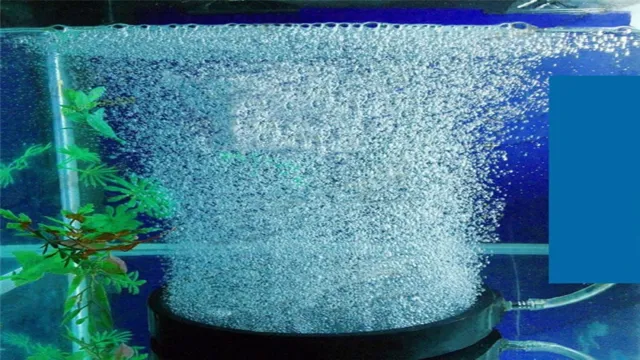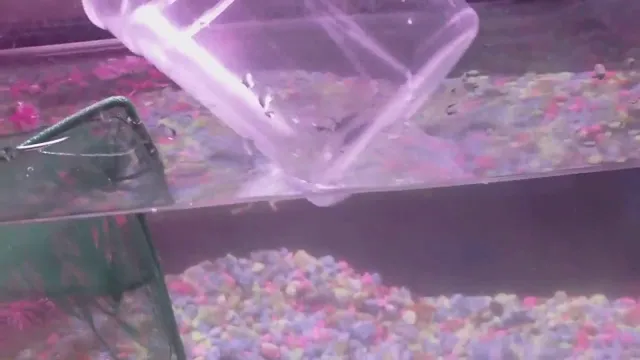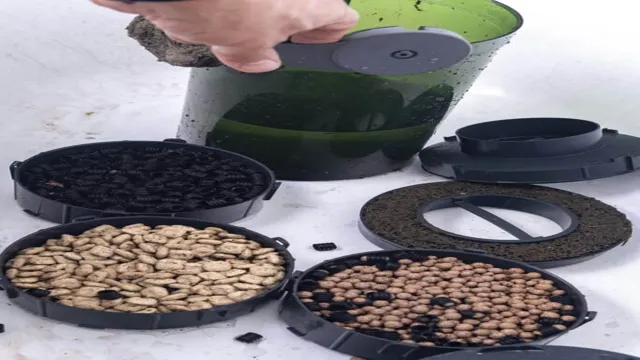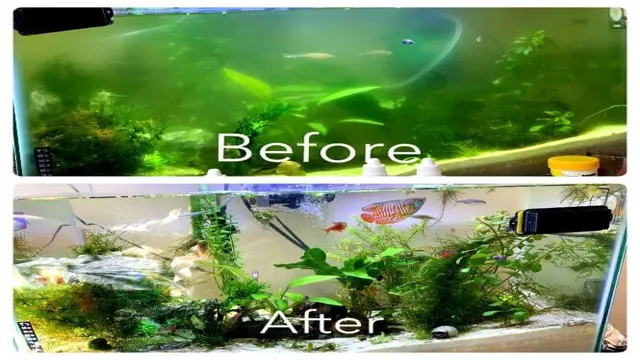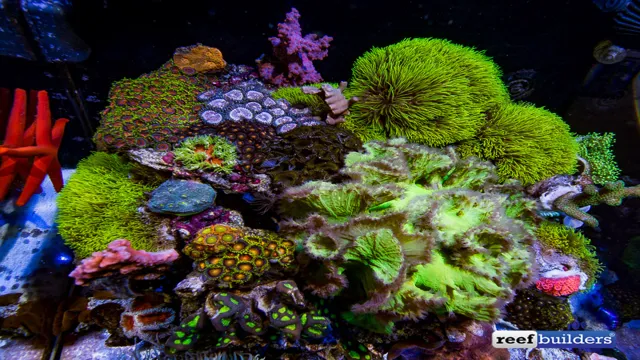Have you always wanted to add a touch of nature to your living space? An aquarium is a fantastic option that can bring serenity, tranquility, and beauty into any room. But what if you don’t want to deal with the hassle and risk of a traditional glass aquarium? Fear not, because with a little DIY magic, you can create your very own aquarium without glass! By choosing alternative materials and constructing a custom design, you can have a unique aquatic habitat that is both functional and visually appealing. Get ready to embark on a fun and creative project that will impress your guests and provide endless entertainment for you and your aquatic pets!
Introduction
Are you interested in creating an aquarium at home but don’t want to use glass? Don’t worry, it’s possible! You can use a variety of materials such as acrylic, plastic, or even large containers like buckets or storage bins. However, it’s important to ensure that the material you use is sturdy enough to hold water and won’t deteriorate over time. Additionally, you’ll need to consider filtration and lighting options for your aquatic pets to thrive.
Don’t forget to do your research on the types of fish and plants that can live in your homemade aquarium and make sure to properly cycle the water before adding any living creatures. A non-glass aquarium can be a unique and affordable way to bring aquatic life into your home.
Explaining the need for an aquarium without glass
aquarium without glass Introduction: Aquariums have been a popular hobby for many years, but not everyone is aware of the option of an aquarium without glass. Glass aquariums are the most commonly used, but they can be heavy, fragile, and difficult to clean. Acrylic tanks have become a popular alternative, but they still have some drawbacks.
An aquarium without glass can provide a modern and unique look, while also being functional and easy to maintain. In this blog, we will explain the need for an aquarium without glass, its advantages, and why it should be considered for your next aquarium setup.

Benefits of a DIY aquarium without glass
DIY aquarium without glass Introduction: If you’re someone who loves marine life and wants to keep fish as pets, you know how important it is to have the perfect aquarium. Many people opt for store-bought tanks that come with glass or acrylic, but did you know that you can also make your own DIY aquarium without glass? Not only is it a fun project to take on, but there are also several benefits that come with having a non-glass aquarium. In this article, we will explore some of these benefits and why you should consider building your own aquarium without glass.
So, let’s dive in!
Step-by-Step Guide
Aquariums are a great way to add some life and color to your home, but they can be expensive and fragile. Luckily, you can make your own aquarium at home without using glass! Here’s how: First, you’ll need to choose a container to use as your tank. Plastic storage containers or large plastic bowls work well, just make sure they’re large enough to comfortably house your fish.
Next, you’ll need to create a filtration system. You can do this by adding a sponge filter to a small air pump. The air pump will push water through the sponge, providing filtration.
Once you have your filtration system set up, you’ll need to add a substrate to the bottom of your tank. Sand or gravel works well and will provide a place for beneficial bacteria to grow. You can also add decorations, like rocks or fake plants, to make your aquarium more interesting.
Finally, you can add water and your fish! Make sure you’re using a dechlorinator to remove any harmful chemicals from the water. And don’t forget to cycle your tank, which means letting it run for a few weeks to establish beneficial bacteria before adding any fish. Making an aquarium at home without glass can be a fun and budget-friendly project.
Just remember to choose a suitable container, set up a filtration system, add substrate and decorations, and cycle your tank before adding any fish. Happy fish-keeping!
Materials required for making a non-glass aquarium
Making a non-glass aquarium can be a fun and unique DIY project for fish-lovers. To start, you’ll need some basic materials. Firstly, you’ll need an appropriate sized container for your aquarium.
Plastic or acrylic containers are great alternatives to glass and are readily available in various sizes from pet stores. Make sure it is large enough to accommodate your fish and plants. Secondly, you’ll need a filtration system to keep the water clean.
A good option is a sponge filter, which is easy to maintain and cost-effective. Thirdly, you’ll need a heater to regulate the temperature of the water. This is important to ensuring your fish stay healthy.
Lastly, you’ll need to purchase substrate, plants, and decorations to make your aquarium look great. These materials can be found at any pet store or online retailers. Overall, once you have gathered all the necessary materials, making a non-glass aquarium is a fun DIY project that can provide a unique and aesthetically pleasing home for your fish.
Building the aquarium’s frame and base
Building the frame and base of an aquarium can be an exciting yet challenging task. It is essential to have a sturdy and stable frame to support the weight of the tank, water, and fish. The first step is to choose the right material for the frame. (See Also: How to Make Aquarium Tank: A Step-by-Step Guide for Beginners)
Most people prefer using wood or metal for this purpose. Once you have selected the material, the next step is to measure and cut it according to the dimensions of your tank. Ensure that all edges are smooth and even to prevent any damage to the tank.
If you decide to use wood, you can apply a coat of sealer or paint to prevent it from getting damaged due to water exposure. The base of the frame should be strong enough to support the entire weight of the tank. You can use plywood or any other sturdy material for the base construction.
It is crucial to level the base properly to prevent any cracks or damage to the tank. With a sturdy and level frame and base, your aquarium is sure to stand the test of time.
Adding a liner for the aquarium
If you’re a fish owner looking to add a new aquarium to your home, there are some crucial steps you’ll need to take to ensure your fish’s well-being. One such step is adding a liner to your aquarium. A liner will help protect your tank from leaks, scratches, and chips, which can be especially important for larger tanks or those holding expensive fish.
To add a liner to your aquarium, begin by thoroughly cleaning the tank, removing any debris or dust. Next, measure the tank’s dimensions and purchase a liner that fits precisely. Carefully place the liner inside the tank, smoothing out any wrinkles or bubbles.
Finally, fill the tank with water slowly, checking for any leaks or bubbles that may indicate a problem with the liner. With a high-quality liner installed, both you and your fish can enjoy your new aquarium worry-free!
Filling the aquarium with water without leaks
Filling your aquarium with water can be an exciting and nerve-wracking task, especially if you’re a beginner to the hobby. The last thing you want is to have leaks, causing all your hard work to go down the drain. However, by following a step-by-step guide, you can ensure that your aquarium is filled with water without any leaks.
First, prepare the aquarium by cleaning it thoroughly with water and a non-toxic cleaning solution. Don’t forget to rinse it well to remove any residue from the cleaning solution. Next, place a layer of substrate at the bottom of the aquarium before adding any decorations or plants.
Once you’re ready to fill the aquarium with water, use a hose or pitcher to add the water slowly. Be sure to fill the aquarium slowly and evenly to avoid any cracks or leaks. As the water level rises, keep an eye out for any leaks or drips and fix them immediately.
Once your aquarium is full, it’s time to add in your filter and heater before introducing any fish or aquatic animals. Following these simple steps will help you fill your aquarium with water without any leaks, allowing you to enjoy your aquatic pets with ease.
Decorating the Aquarium
If you are interested in creating an aquarium at home but don’t have access to glass, don’t worry; it’s still possible to create a beautiful and functional aquarium using alternative materials. One approach is to use a plastic container, such as a large storage bin or even a kiddie pool, as the base for your aquarium. Be sure to choose a container that is large enough to accommodate the fish you plan to keep.
You can then use rocks, gravel, or sand to create a substrate for the bottom of your aquarium. Adding live or artificial plants will provide hiding spots and oxygen for your fish. It’s important to choose the right plants for your fish to ensure they thrive.
Finally, you can add decorations such as rocks, driftwood, or figurines to create a visually appealing environment. Remember to cycle your aquarium before adding fish to ensure the water is safe for them to live in. With a little creativity, you can enjoy the beauty of an aquarium in your own home without needing glass.
Picking Out the Right Habitat and Plants
Now that you’ve got your aquarium set up and filled with water, it’s time for the fun part – decorating! Picking out the right habitat and plants is essential for the health and happiness of your fish. Adding plants brings a natural aesthetic to your aquarium and creates a healthier environment for your fish. Different types of plants will require different levels of light and nutrients, so make sure to choose plants that will thrive in your aquarium setup.
Additionally, incorporating a variety of habitats, such as rocks or driftwood, creates interesting places for your fish to hide and explore. Not only does this make for a more engaging environment for your fish, but it also adds an element of depth to your aquarium’s appearance. When selecting your decorations, be sure to keep in mind specific needs for the breeds of fish that will inhabit the aquarium.
By carefully selecting your decor, you can create an aquarium that is not only aesthetically pleasing but also provides a healthy and happy home for your aquatic companions. (See Also: How to Design an Aquarium for Fish: Tips and Ideas for a Beautiful Underwater Habitat)
Arranging Decorative Elements
Decorating an aquarium is an exciting task, but it can be challenging to know how to arrange the decorative elements. The key is to create a natural-looking environment for your fish to thrive in. Start by selecting the right substrate, such as gravel or sand, to mimic the natural habitat of your fish.
Next, add plants and other aquatic decorations such as driftwood or rocks. Consider the size of your aquarium when choosing how many and what types of decorations to use. For example, a smaller tank will benefit from small, delicate decorations, while a larger tank can handle more significant pieces.
For a fun touch, you can even add themed decorations, such as sunken ships or treasure chests. Remember to leave plenty of open space for your fish to swim and play, and arrange the decorations in a way that creates interesting hiding spots and exploration areas for your fish. With a little creativity and some careful arrangement, your aquarium will be a stunning centerpiece in any room.
Maintaining Your Aquarium
Looking for an alternative to a traditional glass aquarium at home? You can create a unique aquarium using materials like acrylic, Plexiglass, or even plastic containers. To start, determine the size and shape of your aquarium and purchase the appropriate sized container or material. Next, add in a layer of substrate such as gravel or sand for a natural look.
Then, add plants and decorations to provide hiding spaces for fish and enhance the overall aesthetic. After filling the container with water, let it cycle for a few weeks to establish a healthy environment for your aquatic pets. Remember to maintain the aquarium regularly by monitoring the water quality, performing partial water changes, and monitoring the overall health of the fish.
Creating an aquarium at home can be a fun and rewarding hobby, and with the right materials and maintenance, your fish can thrive in their new environment.
Cleaning & Changing Water
Maintaining a clean aquarium is crucial for the health and well-being of your fish. One of the most important aspects of maintaining an aquarium is cleaning and changing the water. Aquarium water needs to be regularly changed to remove any buildup of harmful substances that can harm your fish.
It’s generally recommended to change around 25% of the water every other week or 10-15% every week. When changing the water, it’s important to remove any debris or waste from the bottom of the tank, and to avoid using harsh chemicals that can harm your fish. To make the process easier, consider investing in a gravel vacuum to clean the substrate, as well as a water conditioner to neutralize any harmful substances that may be in the tap water.
By regularly cleaning and changing the water in your aquarium, you can ensure that your fish stay healthy and happy.
Feeding Your Fish
Feeding your fish is a crucial part of maintaining a healthy aquarium. A well-balanced diet is necessary for your fish to thrive, and it’s essential to provide them with the right amount of food. Overfeeding can be harmful, causing excess waste and polluting the water.
When selecting fish food, it’s crucial to consider the nutritional content and the specific dietary requirements of each species. For example, herbivorous fish require a diet high in plant matter, while carnivorous fish require a protein-rich diet. Additionally, feeding times should be consistent and portion control should be carefully monitored.
By providing your fish with a balanced and appropriate diet, you can ensure their health and happiness in your aquarium.
Maintaining Temperature
Maintaining Temperature in Your Aquarium Temperature maintenance is one of the most important aspects of aquarium care. Different species of fish require different water temperatures to survive, and maintaining a consistent temperature in your aquarium is crucial for their health. The first step to maintaining temperature is investing in a good quality aquarium heater.
You should choose a heater that matches the size of your tank and can accurately maintain the desired temperature. It is also important to regularly monitor the temperature of your aquarium to ensure that it stays within the desired range. Factors like room temperature, aquarium lighting, and water flow can all impact the temperature of your aquarium, so it’s important to keep those in mind when monitoring your water temperature.
Remember to avoid sudden temperature changes, as this can be harmful to your fish. Overall, maintaining the temperature in your aquarium will ensure that your fish remain healthy and happy.
Conclusion
In conclusion, with a little creativity and resourcefulness, anyone can create an aquarium at home without using traditional glass tanks. From repurposing old household items to using unconventional materials, the possibilities for a unique and personalized aquarium are endless. So why settle for a boring glass tank when you can unleash your imagination and dive into the world of DIY aquariums?” (See Also: How to Get Free Aquarium Fish: Expert Guide to Find Free Fish for Your Tank)
The benefits and convenience of having a DIY aquarium without glass
Maintaining your DIY aquarium without glass is much easier than you might think. Not only is it a convenient way to have an aquarium of your own, but it also provides several benefits that a glass aquarium can’t offer. One key advantage is that it’s much lighter than glass, making it easier to move and transport.
Another perk is that it’s less likely to crack or shatter, which eliminates the fear of costly replacements. To keep your DIY aquarium healthy, you’ll need to perform regular maintenance tasks such as cleaning the tank and replacing the water. You’ll also need to ensure your fish are fed appropriately and that the water temperature is at the right level.
With a little upkeep, however, you’ll be rewarded with a beautiful and thriving aquarium to enjoy. So if you’re looking for a hassle-free way to bring some aquatic life into your home, a DIY aquarium without glass is definitely worth considering.
Final tips for maintaining and enjoying your new aquarium
Maintaining your new aquarium is crucial to allow for your fish to thrive and enjoy their new habitat. Firstly, it’s important to keep the water clean by regularly changing 10-20% of the water every week. This will help to remove any harmful chemicals or toxins that may build up over time.
Additionally, ensure that the aquarium is not overcrowded, as this can lead to stress and disease amongst your fish. Secondly, maintaining a consistent temperature is necessary for the health of your fish. Investing in a thermometer and a heater will help to regulate the temperature of the water.
Lastly, regular testing of the water quality is essential to ensure that the necessary levels of ammonia, nitrate, and pH are maintained for your fish to thrive. Remember that with the right maintenance, your aquarium can provide a peaceful and enjoyable environment for both you and your fish for years to come.
FAQs
What materials do I need to make an aquarium at home without glass?
You can use materials like clear acrylic, polycarbonate, or Plexiglass sheets to create the walls of your aquarium. Additionally, you’ll need a waterproof sealant, a pump, and a filter.
Can I make an aquarium at home without any experience?
Yes, you can! However, you may want to start with a smaller aquarium to practice your skills before attempting a larger one.
How big can I make my DIY aquarium without using glass?
The size of your aquarium will depend on the materials you use and your skill level. However, acrylic sheets are typically stronger than glass and can support larger aquariums.
Is it expensive to make an aquarium at home without glass?
It can be more expensive than buying a traditional glass aquarium, but it will depend on the size and materials you choose.
How do I waterproof my DIY aquarium without using glass?
Use a waterproof sealant to secure the seams and joints of your aquarium. Be sure to let the sealant dry fully before adding water.
Can I use my DIY aquarium without a filter or pump?
It is not recommended to use an aquarium without a filter or pump, as these components help maintain the health and cleanliness of your fish.
What kind of fish can I keep in a DIY aquarium without glass?
You can keep a variety of freshwater fish, such as goldfish, guppies, and tetras, in your DIY aquarium. Just be sure to research their specific care requirements before adding them to your tank.



